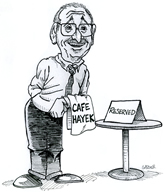President Trump gave the economy another jolt of uncertainty on Monday when he signed executive orders imposing 25% tariffs on all steel and aluminum imports. His advisers say these tariffs are economically “strategic” rather than a bargaining chip for some other goal. Is the strategy to harm U.S. manufacturers and workers?
That’s what his first-term tariffs did, and it’s worth revisiting the damage of that blunder as he threatens to repeat it. In March 2018, Mr. Trump announced 25% tariffs on steel and 10% on aluminum under the pretext of protecting national security. Then, as now, most U.S. metal imports came from allies including Canada, Mexico, Europe, South Korea and Japan.
Mr. Trump said tariffs were needed to boost domestic steel and aluminum production. But U.S. production was already increasing amid a surge in capital investment unleashed by his deregulation and 2017 tax reform. U.S. steel capacity utilization climbed to 78.5% in March 2018 from 72.4% in December 2016.
The real goal of U.S. steel and aluminum companies that wanted the tariffs was to boost their bottom lines. Raising prices on foreign imports allowed them to charge more. The price was paid by U.S. secondary metal producers and downstream manufacturers.
…..
This is political rent-seeking at its most brazen, and it benefits the few at the expense of the many. None of this matters to Mr. Trump, whose dogmatic views on tariffs can’t be turned by evidence. But we thought our readers would like to know the rest of the story.
Eric Boehm explains that “trade wars that never happen still have costs.” A slice:
But tariffs that never materialize create costs too—and that’s something we know, in part, because of how Trump handled trade policy during his first term. Uncertainty created by Trump’s trade policies reduced aggregate U.S. investment by as much as $47 billion in 2018, according to a 2020 study in the Journal of Monetary Economics.
The authors of that paper wrote that “all measures suggest that uncertainty about trade policy has recently shot up to levels not seen since the 1970s.” They concluded that “both higher expected tariffs and increased uncertainty about future tariffs deters investment.”
Trump’s fans and allies try to justify his chaotic trade policies by arguing that the president is merely negotiating with other countries. That would make more sense if he wasn’t picking an unnecessary fight with two of America’s biggest trading partners, countries with which Trump literally negotiated a new trade deal during his first term.
Even so, there’s no negotiating with the reaction of the markets—which responded negatively to the tariff threats and now seem to be pricing in the uncertainty going forward.
GMU Econ alum Dan Mitchell offers lessons in Trade 101 for Trump and other protectionists.
For example, when Trump imposed tariffs on Canada, he claimed they were needed to halt the flows of fentanyl and illegal immigrants across our northern border. This seemed obviously a pretext to justify tariffs that he’s been promising for years, not because of security concerns, but because he thinks they’re good for the economy.
As pretexts go, this one is pretty thin. In fiscal 2024, Customs and Border Protection caught 23,721 people trying to illegally cross from Canada into the United States, just 1.5 percent of total apprehensions — and for comparison, in 2023, more than 30,000 undocumented migrants crossed in the other direction. Similarly, the Drug Enforcement Administration seized 43 pounds of fentanyl coming across our northern border, compared to 21,148 pounds coming from Mexico. Canada is simply not a significant contributor to our fentanyl problem.
Nonetheless, once Trump said it, the right wing on X became very, very invested in the idea that Canadian fentanyl was a major problem that needed a drastic solution. Suggest that tariffs were a solution in search of a problem, and you’d be mobbed by people who were sincerely outraged by an issue they’d never heard of three days ago.
Peter Earle warns that government officials aren’t trustworthy stewards of people’s assets.
Brian Albrecht concludes that “DeepSeek shows there’s no AI monopoly.” A slice:
“The best of all monopoly profits is a quiet life,” observed the late British economist and Nobel laureate Sir John Hicks. But there’s no quiet life in artificial intelligence.
When Chinese startup DeepSeek recently demonstrated it could train world-class AI models using a fraction of the computing resources required by industry leaders, it revealed something crucial about competition in AI: dominance is more fragile than markets and regulators believed. Through clever engineering, DeepSeek claims to have achieved performance rivaling top firms OpenAI and Anthropic. And it did so while reportedly spending just $5 million on compute—a rounding error compared with the budgets of leading AI labs.
This type of breakthrough challenges conventional antitrust wisdom, which sees in AI markets a system of already-entrenched monopolies. Despite their massive scale, even the AI companies that once appeared unassailable now find themselves racing to keep up with breakthroughs from unexpected directions.
The number of private school choice programs in the country grew to 81 from 65 from 2020-2024, according to the education nonprofit EdChoice. But only 33 states have choice programs, which means there are many more children and parents to liberate from lousy union schools.



